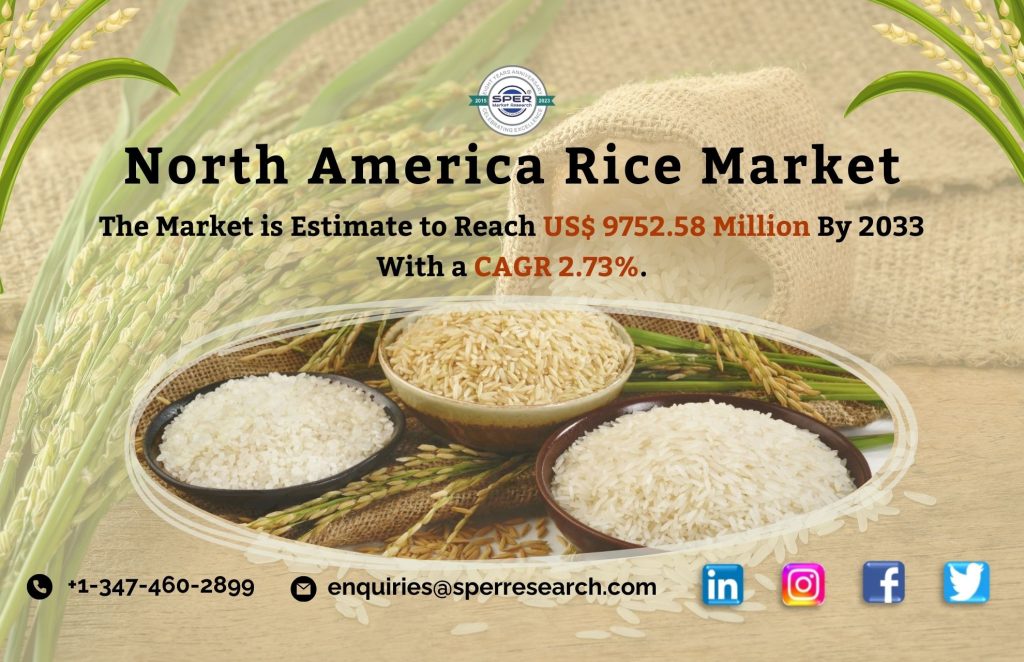North America Rice Market Size 2023- Industry Share, Revenue, Growth Drivers, Upcoming Trends, Business Challenges, Opportunities and Future Competition till 2033: SPER Market Research

One of the most extensively consumed staple foods in the world is rice, a cereal grain. It is referred to as Oryza sativa and is a member of the grass family. It can be identified by its tiny, oval-shaped seeds, which are typically either black, brown, or white. A staple grain and rich source of carbohydrates, rice is found throughout much of the world, but especially in Asia. It can be prepared in a number of ways, such as boiling, steaming, and frying, and used as the foundation for many other recipes. Rice comes in a variety of varieties, each with a unique flavour, taste, and nutritional makeup. White rice, brown rice, black rice, and other types are popular kinds.
According to SPER market research, ‘North America Rice Market Size- By Product Type, By Rice Category, By Grain Size, By Nature, By End User, By Distribution Channel – Regional Outlook, Competitive Strategies and Segment Forecast to 2033’ state that the North America Rice Market is predicted to reach USD 9752.58 million by 2033 with a CAGR of 2.73%.
Drivers:
The rice market has expanded dramatically in recent years as a result of rising demand for US rice in emerging and developing countries throughout the world, despite the fact that North America is mostly an exporter of rice with a low domestic consumption value. Aside from government support, some key factors influencing market prosperity include access to high-quality inputs, good crop management practices, and current technologies. This contributes to high-quality rice production at harvest and maintains that quality throughout the milling and distribution chain. Simultaneously, incredibly efficient transportation and logistics contribute to grow the North American rice market.
Restraints:
Weather-related grain price volatility is a significant barrier to market growth. Fluctuations in rice supplies may impede market expansion. Lower rice harvests raise rice prices in response to greater demand. This may also reduce rice demand and the quantity of customers. Companies’ reliance on climate causes instability in rice pricing and quality, resulting in a demand-supply mismatch in important rice-consuming countries. Climate change and unfavourable weather conditions can have an impact on crop yields and quality. Global climate conditions are quickly changing, resulting in severe droughts and floods. Short supply leads to higher rice prices, which boosts the price for end users.
Request For Free Sample Report @ https://www.sperresearch.com/report-store/north-america-rice-market.aspx?sample=1
Impact of COVID-19 on North America Rice Market
COVID-19 has created an all-encompassing disaster in all countries, causing local economic disruptions, decreased external demand, price collapse, and a collapse in product supply and demand. Following the outbreak, demand for rice and rice products increased dramatically because there would be no more mobility restrictions, making product supply easier. Furthermore, as companies developed processing units to produce rice, demand in the food processing, household, and flour industries surged, potentially driving market expansion. Furthermore, since the COVID-19 epidemic, demand for rice has increased in both the home and retail markets. Furthermore, customer interest in rice’s health benefits, as well as research development, are likely to drive the North American rice business ahead.
North America Rice Market Key Players:
The United States is the largest rice grower in North America. The largest rice-producing regions in the United States are Arkansas Grand Prairie, Mississippi Delta, Gulf Coast, and California’s Sacramento Valley. Furthermore, the sector’s main companies include Riceland Foods, St. Maries Wild Rice & Ankeny Lakes Wild Rice Company, Doguet’s Rice Milling Company, and Supreme Rice.
North America Rice Market Segmentation:
The SPER Market Research report seeks to give market dynamics, demand, and supply forecasts for the years up to 2033. This report contains statistics on product type segment growth estimates and forecasts.
By Product Type: Based on the Product Type, North America Rice Market is segmented as; Brown Rice, White Rice, Black Rice, Red Rice.
By Rice Category: Based on the Rice Category, North America Rice Market is segmented as; Parboiled Rice, Jasmine Rice, Basmati Rice, Wild Rice, Others.
By Grain Size: Based on the Grain Size, North America Rice Market is segmented as; Short Grain Rice, Medium Grain Rice, Long Grain Rice.
By Nature: Based on the Nature, North America Rice Market is segmented as; Organic, Conventional.
By End User: Based on the End User, North America Rice Market is segmented as; Household/Retail, Food Processing Industry, Flour Industry, Animal Feed, Others.
By Distribution Channel: Based on the Distribution Channel, North America Rice Market is segmented as; Direct, Indirect.
By Region: This research includes data for North America, Asia-Pacific, Latin America, Middle East & Africa and Europe.
This study also encompasses various drivers and restraining factors of this market for the forecast period. Various growth opportunities are also discussed in the report.
For More Information, refer to below link:-
North America Rice Market Future Outlook
Related Reports:
Follow Us –
LinkedIn | Instagram | Facebook | Twitter
Contact Us:
Sara Lopes, Business Consultant – U.S.A.
SPER Market Research
+1-347-460-2899





